Nostrand Avenue station (IND Fulton Street Line)
Nostrand Avenue is a two-level express station on the IND Fulton Street Line of the New York City Subway, located at the intersection of Nostrand Avenue and Fulton Street in Bedford–Stuyvesant, Brooklyn. It is served by the A train at all times and the C train at all times except late nights.
Nostrand Avenue | |||||||||||
|---|---|---|---|---|---|---|---|---|---|---|---|
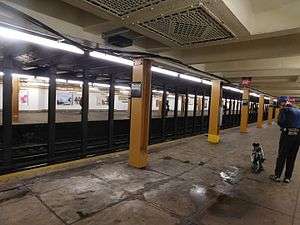 A view of the upper level | |||||||||||
| Station statistics | |||||||||||
| Address | Nostrand Avenue & Fulton Street Brooklyn, NY 11216 | ||||||||||
| Borough | Brooklyn | ||||||||||
| Locale | Bedford-Stuyvesant | ||||||||||
| Coordinates | 40°40′50″N 73°56′59″W | ||||||||||
| Division | B (IND) | ||||||||||
| Line | IND Fulton Street Line | ||||||||||
| Services | A C | ||||||||||
| Transit connections | |||||||||||
| Structure | Underground | ||||||||||
| Levels | 2 | ||||||||||
| Platforms | 4 side platforms (2 on each level) | ||||||||||
| Tracks | 4 (2 on each level) | ||||||||||
| Other information | |||||||||||
| Opened | April 9, 1936[1] | ||||||||||
| Station code | 179[2] | ||||||||||
| Accessible | not ADA-accessible; accessibility planned | ||||||||||
| Wireless service | |||||||||||
| Opposite-direction transfer available | No | ||||||||||
| Traffic | |||||||||||
| Passengers (2019) | 5,608,232[4] | ||||||||||
| Rank | 78 out of 424[4] | ||||||||||
| Station succession | |||||||||||
| Next north | Hoyt–Schermerhorn Streets (express): A Franklin Avenue (local): A | ||||||||||
| Next south | Kingston–Throop Avenues (local): A Utica Avenue (express): A | ||||||||||
| |||||||||||
| |||||||||||
| |||||||||||
The station was planned as part of the construction of the Independent Subway System (IND)'s Fulton Street Line. Construction of the station began around 1929, and it was opened to service on April 9, 1936. Several of the station's entrances were closed in the late 20th century due to crime. In the 2010s and 2020s, the Metropolitan Transportation Authority (MTA) announced plans to make the station ADA-accessible and to reopen closed exits.
Nostrand Avenue has four tracks and four side platforms, with two platform levels. Express trains stop on the upper level while local trains stop on the lower level. This is because, in the original design for the station, the Nostrand Avenue station was slated to be a local station with only two platforms, and the current upper level was intended to be a mezzanine.
History
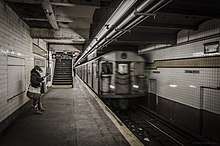
Early history
The Nostrand Avenue station was constructed as part of the IND Fulton Street Line, the main line of the city-owned Independent Subway System (IND)'s main line from Downtown Brooklyn to southern Queens.[5] The groundbreaking for the line was held on April 16, 1929, at Fulton Street and Arlington Place, located at the site of the future station.[6] The Nostrand Avenue station opened on April 9, 1936, as part of an extension of the IND from its previous Brooklyn terminus at Jay Street–Borough Hall, which opened three years earlier, to Rockaway Avenue.[1] The new IND subway replaced the BMT Fulton Street Elevated, and this station replaced the elevated's Nostrand Avenue station, which was formerly above the current subway station until it closed on May 31, 1940.[7]
On January 12, 1943, business, church and civic leaders from Brooklyn testified before the City Affairs Committee of the New York City Council, asking that the Bedford Avenue entrances to this station and the Classon Avenue entrances to the Franklin Avenue station be opened. These entrances had been constructed with the rest of the line, but had been boarded up with the line's completion.[8] On February 4, 1943, the City Council passed a resolution urging the New York City Board of Transportation (NYCBOT) to open the entrances.[9] At the time, the staircases to Bedford Avenue were only used for exits.[10]
As a result of a year-long campaign from the Bedford–Stuyvesant Neighborhood Council, the NYCBOT agreed to open the Bedford Avenue entrances to the station.[11] The Neighborhood Council disclosed the announcement on June 16, 1950, and the NYCBOT promptly began work opening the entrances.[11] The entrances opened on July 24, 1950, after a change booth and turnstiles were installed, being open on Mondays to Fridays between 6:30 and 10:30 a.m., and from 3:30 to 7:30 p.m.[12]
Deterioration and crime
In 1981, the Metropolitan Transportation Authority (MTA) listed the station among the 69 most deteriorated stations in the subway system.[13] The Bedford Avenue entrances were closed by the New York City Transit Authority (NYCTA) before or during the 1980s.[14][15][16] Though the entrances were closed, a portion of the mezzanine remained open to allow for free crossovers between directions.[17]
This passageway was closed on an emergency basis in April 1991, after the NYCTA, on March 28, 1991, ordered the closing of the 15 most dangerous passageways in the subway system within a week following the rape of a woman behind a pile of debris in the subway passageway connecting the 34th Street–Herald Square and 42nd Street–Bryant Park stations under Sixth Avenue on March 20, 1991.[18][19] The locations were chosen based on crime volume, lighting, traffic and physical layout, and were closed under the declaration of a public safety emergency, and were blocked off with plywood and fencing until public hearings were held and official permission was obtained.[20] By closing the entrances, the transit police could deploy many officers to other parts of the system. This passageway was chosen because the station had 96 felonies since January 1, 1990.[21][22] In January 1992, the MTA Board approved a request by the NYCTA to close 43 full- or part-time station areas at 30 station complexes, including this passageway. With the closure of the passageway, during late nights, when the part-time booth to the Queens-bound platform was closed, passengers would use the existing high entrance and exit turnstiles. The NYCTA was also considering making this booth full-time.[17]
On February 17, 2005, transit workers found two trash bags on the station's tracks, which contained the body parts of 19-year-old Rashawn Brazell, a Bushwick resident who had been reported missing three days earlier. In February 2017, 38-year-old Kwauhuru Govan was arrested for Brazell's murder.[23][24]
Renovation
On December 11, 2015, New York City Transit released its Review of the A and C Lines report. Among the various aspects discussed, the report discussed the option of reopening closed station entrances along these routes. The report concluded that if additional capital funding was provided, or if the Federal Transit Administration's interpretation of the Americans with Disabilities Act of 1990 (ADA) reverted its original flexible approach, reopening the closed entrances at Nostrand Avenue would become more feasible.[25]:37–38 The report stated that reopening the Bedford Avenue entrances would reduce congestion at the Nostrand Avenue entrance, would reduce uneven loading on A and C trains, and would cut the walking distance for riders going to and from areas west of Arlington Place, including bus riders. It also found that reopening the closed entrances at Fulton Street and Arlington Place to the northbound platform would provide similar benefits at a lower cost.[25]:73
Despite overcrowding at the Nostrand Avenue station, the Bedford Avenue entrances remained closed for over 25 years.[26][27][28] In 2019, the MTA announced that this station would become ADA-accessible as part of the agency's 2020–2024 Capital Program.[29] On February 6, 2020, the MTA held a press conference in the closed Bedford Avenue mezzanine of the station and announced that the Bedford Avenue entrances to the station would be reopened by the end of the year. Reopening the entrances will cost $2 million, with $1.25 million coming from New York City Transit, $500,000 from Assembly Member Tremaine Wright and $250,000 from State Senator Velmanette Montgomery. The work, which will be completed by New York City Transit staff, will entail the installation of lighting and turnstiles, the rehabilitation of stairways, the scraping and repainting of areas, the repairing and replacement of tile, and the construction of new sidewalk entrances.[26][27][28][30] The entrances will reduce severe overcrowding during the p.m. rush hour, allow for free transfers between directions, will better serve areas west of Arlington Place, and will provide a direct connection to northbound B44 SBS service. The reopening of the entrance was made possible because of future ADA improvements at the station.[27][28]
Station layout
| G | Street level | Exit/entrance |
| B1 | Bedford Avenue mezzanine | Closed |
| B2 Express platforms |
North mezzanine | Fare control |
| Side platform | ||
| Westbound express | ← | |
| Eastbound express | | |
| Side platform | ||
| South mezzanine | Fare control | |
| B3 Local platforms |
Side platform | |
| Westbound local | ← ← | |
| Wall | ||
| Trackway | No service | |
| Trackway | No service | |
| Wall | ||
| Eastbound local | | |
| Side platform | ||
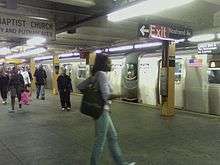
Nostrand Avenue is an express station, serving all trains that stop there (as opposed to a local station that serves only local trains).[31] It is the only two-level express station in the system that has the express tracks on the upper level and the local tracks on the lower one. The station was originally planned to be a conventional local station with four tracks and two side platforms, with a mezzanine, as proven by the fact that the upper-level platforms are wider than the lower level ones (which would have been consistent with the design of a mezzanine), and two unused trackways exist on the lower level between the local tracks (which would have been consistent with the typical design of a local station on a four-track line). A curtain wall separates the local tracks from the unused trackways on both sides. On either side of the station, the express tracks ascend from the local tracks to serve the upper level, then descend to rejoin them.[32]
The station's trim-line is butterscotch yellow with a medium mustard brown border and is three tiles high on all of the platform walls as well as the track walls on the lower level. Below the trim-line is "NOSTRAND" tiled in white on a black border and name tablets that read "NOSTRAND AVE." in white sans-serif font on the same (but reversed) contrasting color background and border (mustard brown/butterscotch yellow).[33] There is artwork from the Ronald Edmonds Learning Center Community School on the northbound platform.[34]
The platforms have directional signs to the other level in the same style as the name tablets and signs to the exit in the same style as the name tiles.[35] Each upper-level platform has its own same-level fare control, and there are no crossovers or crossunders.[25] This is one of only three express stations in the system that do not allow free transfers between directions. The others are 86th Street on the IRT Lexington Avenue Line and Bergen Street on the IND Culver Line (the lower level of the latter is not in use as of 2019). Free crossovers will be possible with the reopening of the Bedford Avenue mezzanine by the end of 2020.[30] Each fare control area has a turnstile bank, token booth, and two street stairs. The Manhattan-bound side stairs lead to both northern corners of Nostrand Avenue and Fulton Street while the Queens-bound side stairs lead to both southern corners.[25]
Exits
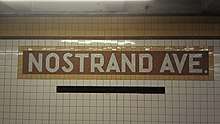
Each platform has its own exits to the corners of Nostrand Avenue and Fulton Street, which are 15 feet (4.6 m) long and 6 feet (1.8 m) wide. The following exits each contain one staircase:[36]
| Exit location[37] | Platform served |
|---|---|
| SW corner of Nostrand Avenue and Fulton Street | Southbound |
| SE corner of Nostrand Avenue and Fulton Street | Southbound |
| NW corner of Nostrand Avenue and Fulton Street | Northbound |
| NE corner of Nostrand Avenue and Fulton Street | Northbound |
| NE corner of Bedford Avenue and Fulton Street | Both (future) |
| SE corner of Bedford Avenue and Fulton Street | Both (future) |
The station has a full-time booth in the Nostrand Avenue fare control area on the northbound platform, and used to have a part-time booth at the Nostrand Avenue fare control area on the southbound platform.[17]
Both upper-level platforms have a passage at their railroad north (geographical west) ends to a large mezzanine with a crossover.[38] Two stairs from this mezzanine lead to either eastern corner of Bedford Avenue and Fulton Street,[16] some 1,000 feet (300 m) west of the Nostrand Avenue entrances. The entrances from Bedford Avenue were closed prior to the 1980s due to increasing crime, but the crossover and passages were retained until 1992, when high crime rates in the subway system prompted the MTA to close the crossover as well.[17] In February 2020, the MTA announced the reopening of the mezzanine, entrances, and accompanying passages, with an anticipated opening date of late 2020.[30]
The Manhattan-bound upper level also has a closed fare control area to both northern corners of Arlington Place and Fulton Street.[25][37] The Arlington Place entrance is located behind a tiled wall with a door.[39]
References
- "New Subway Link Opened By Mayor; He Tells 15,000 in Brooklyn It Will Be Extended to Queens When Red Tape Is Cut". The New York Times. April 9, 1936. ISSN 0362-4331. Retrieved August 15, 2016.
- "Station Developers' Information". Metropolitan Transportation Authority. Retrieved June 13, 2017.
- "NYC Subway Wireless – Active Stations". Transit Wireless Wifi. Retrieved November 13, 2019.
- "Facts and Figures: Annual Subway Ridership 2014–2019". Metropolitan Transportation Authority. 2020. Retrieved May 26, 2020.
- Duffus, R.L. (September 22, 1929). "Our Great Subway Network Spreads Wider; New Plans of Board of Transportation Involve the Building of More Than One Hundred Miles of Additional Rapid Transit Routes for New York" (PDF). The New York Times. Retrieved August 19, 2015.
- "New Fulton Street Subway Officially Started as Byrne Turns Earth; Ground is Broken For Subway Line Along Fulton St.; Byrne Turns First Spade of Arlington Pl. Earth as Merchants Applaud". Brooklyn Daily Eagle. April 17, 1929. p. 4. Retrieved August 28, 2016 – via Newspapers.com.
- "Last Train is Run on Fulton St. 'El'". New York Times. June 1, 1940. ISSN 0362-4331. Retrieved February 7, 2020.
- "Civic Leaders Urge Subway Station Changes: Advocate Enlarging Entrances To Reduce Overcrowding". The Brooklyn Daily Eagle. January 13, 1943. Retrieved February 7, 2020.
- "Extra Station Entrances Needed". The Brooklyn Daily Eagle. February 5, 1943. Retrieved February 7, 2020.
- "Report of the Committee on City Affairs in Favor of Adopting a Resolution Requesting the Board of Transportation to Provide Adequate Entrances, as Well as Exits in the Bedford Section of Brooklyn, at the Classon Avenue Side of the Franklin Avenue Subway Station and the Bedford Avenue Side of the Nostrand Avenue Subway Station of the Eighth Avenue Independent Subway System" (PDF). The City Record. New York City. 71 (21166): 448. February 4, 1943.
- "Free Transfers, New Subway Exit Won for Bedford". New York Daily News. June 16, 1950. Retrieved February 21, 2019.
- "Rush Hour Service Provided For Bedford Ave. Subway Entrance". The Brooklyn Daily Eagle. July 21, 1950. Retrieved February 7, 2020.
- Gargan, Edward A. (June 11, 1981). "Agency Lists Its 69 Most Deteriorated Subway Stations". The New York Times. Retrieved August 13, 2016.
- "1241-43 Bedford Avenue". nycma.lunaimaging.com. New York City Department of Records and Information Services. 1983–1988. Retrieved February 7, 2020.CS1 maint: date format (link)
- "1245-51 Bedford Avenue". nycma.lunaimaging.com. New York City Department of Records and Information Services. 1983–1988. Retrieved February 7, 2020.CS1 maint: date format (link)
- "Bedford-Stuyvesant Neighborhood Map". Flickr. New York City Transit Authority. 1980s. Retrieved February 9, 2020.
-
- January 1992 Transit Authority Committee Agenda. New York City Transit Authority. January 17, 1992. pp. E.14.
- January 1992 Transit Authority Committee Agenda. New York City Transit Authority. January 17, 1992. pp. E.44.
- Wolff, Craig (March 23, 1991). "Subway Path Boarded Shut After a Rape". The New York Times. ISSN 0362-4331. Retrieved February 1, 2018.
- Diamond, Randy (March 22, 1991). "Subway rape". New York Daily News. p. 12. Retrieved February 24, 2019.
- "Tunnel vision". New York Daily News. March 30, 1991. p. 19. Retrieved February 24, 2019.
- Sims, Calvin (March 29, 1991). "15 More Areas In Subways To Be Closed". The New York Times. ISSN 0362-4331. Retrieved February 1, 2018.
- Chang, Dean (March 29, 1991). "15 dangerous corridors to be closed". New York Daily News. p. 7. Retrieved February 24, 2019.
- "DNA from victim's fingernails leads to arrest in cold case murder of Brooklyn girl". ABC7 New York. November 17, 2016. Retrieved February 22, 2017.
- "Accused killer charged in 2005 subway body parts murder". ABC7 New York. February 22, 2017. Retrieved February 22, 2017.
- Review of the A and C Lines (PDF) (Report). Metropolitan Transportation Authority. December 11, 2015. Archived from the original (PDF) on February 3, 2020. Retrieved January 19, 2016.
- Meyer, David (February 6, 2020). "MTA to reopen long-shuttered entrances at bustling Brooklyn station". New York Post. Retrieved February 7, 2020.
- "MTA to reopen long-closed stretch of Nostrand Avenue subway station". ABC7 New York. February 6, 2020. Retrieved February 7, 2020.
- Guse, Clayton (February 7, 2020). "MTA to reopen long-shuttered entrance to busy Brooklyn subway station". New York Daily News. Retrieved February 7, 2020.
- "MTA Announces 20 Additional Subway Stations to Receive Accessibility Improvements Under Proposed 2020-2024 Capital Plan". mta.info. Metropolitan Transportation Authority. December 19, 2019. Retrieved December 25, 2019.
- "MTA Announces Reopening of Bedford Avenue Entrances to Nostrand Avenue AC Subway Station". mta.info. Metropolitan Transportation Authority. Retrieved February 7, 2020.
- "Subway Map" (PDF). Metropolitan Transportation Authority. October 21, 2019. Retrieved January 18, 2018.
- Dougherty, Peter (2006) [2002]. Tracks of the New York City Subway 2006 (3rd ed.). Dougherty. OCLC 49777633 – via Google Books.
- Cox, Jeremiah (December 29, 2008). "Another Nostrand Av name tablet, with text beneath it for the exit to Nostrand Ave". subwaynut.com. Retrieved February 7, 2020.
- Rosenfeld, Robbie (April 28, 2013). "Artwork from the Ronald Edmonds Learning Center Community School District 13 Brooklyn". nycsubway.org. Retrieved February 7, 2020.
- Cox, Jeremiah (May 30, 2013). "Mosaic for local trains and the one open entrance". subwaynut.com. Retrieved February 7, 2020.
- "Subway—Sidewalk Interface Project 1. Nostrand Avenue" (PDF). transalt.org. TransAlt. Retrieved February 7, 2020.
- "NYC DoT Maps: Nostrand Av (A)(C)" (PDF). mta.info. New York City Department of Transportation. 2016. Retrieved July 5, 2016.
- Nostrand Avenue Station ABANDONED Entrances and Passageways (IND Fulton Street Line), retrieved February 6, 2020
- Cox, Jeremiah (January 29, 2013). "This wall with a door was once the Bedford Avenue entrance". subwaynut.com. Retrieved February 7, 2020.
External links
| Wikimedia Commons has media related to Nostrand Avenue (IND Fulton Street Line). |
- nycsubway.org – IND Fulton Street Line: Nostrand Avenue
- Station Reporter—A Lefferts
- Station Reporter—A Rockaway
- Station Reporter—C Train
- The Subway Nut—Nostrand Avenue Pictures
- Nostrand Avenue entrance from Google Maps Street View
- Platforms from Google Maps Street View
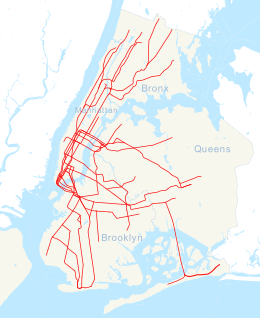


%26groups%3D_751c392c5ea4ddaa975409ae9a2a8f464300957b.svg)